Red Team: Regime Counterinsurgency in Syria
Vince Tumminello
SWJ Editors note: The following red team assessment of Syrian prospects for counterinsurgency was written in December of 2015. It is a blueprint for Syrian military, economic, and political success in the coming years. Many of the recommendations made in this assessment have already been implement, some are now underway, and others seem likely based on recent developments between Russia and the United States.
The Syrian insurgency, alternatively known as the Syrian conflict or Syrian civil war, began in March 2011- growing out of seemingly innocuous protests around Damascus[i]. The ongoing struggle between the Syrian regime, led by Bashar Al-Assad, and hundreds of individual insurgent elements was neither spontaneous in its development, nor is it unprecedented in scope. The conflict is, at once, the latest iteration in a centuries old conflict between religious sects and among tribes and families[ii], a struggle over the responsibilities of government, and a violent debate over the role of religion in society[iii]. At the same time, it is also a heretofore-unseen escalation of Wahhabi-inspired jihadism[iv] and the struggle to contain its practitioners[v], a regional contest among competing power blocs[vi], and a global contest between great powers[vii], a lone super power[viii], and rising powers[ix].
The elements of this insurgency and the combination of accelerants that fueled its escalation reveal nothing new, but rather reinforce the notion that history has an obvious rhythm. In this rhythm lie clues for the counterinsurgent to navigate the seemingly intractable problem set that faces the Syrian regime today[x]. Efforts against insurgent groups fall generally into three approaches: population-centric, enemy-centric, and punishment. These approaches have been used with widely varying results since the first century BCE[xi] and before. Modern counterinsurgents have employed all of these approaches, in mutual exclusivity and in combination. The Syrian conflict, in all its complexity, may be seen as several separate yet overlapping insurgencies. Strategic recommendations for the Syrian regime, then, cannot be unilateral in approach and must be tooled to the locality, adversary, and objective. This paper will describe, in detail, a five-year counterinsurgency campaign plan for Syria that blends enemy-centric and population-centric approaches, pursued through political action, diplomacy, overt military operations, and covert action.
Assessing the Requirements for Syria
From Insurgency to Civil War[xii]
Throughout 2011 and early 2012, during the first phase of the insurgency, the Bashar al-Assad regime implemented an enemy-centric counterinsurgency approach. This approach attempted to mirror the approach of Hafez Al-Assad, his father, during the 1980s uprising. To crush the new movement, Bashar used selective deployment of elite Alawite forces and paramilitary units to conduct a clear and hold campaign. While this methodology would typically fall under an eradication enemy-centric approach, the actual manifestation was closer to indiscriminate annihilation.
These initial policies had two short-order effects: 1) it alienated the population (specifically along sectarian lines) and 2) it caused mass defections of Sunni military personnel. In sum, rather than successfully crushing the resistance, the Assad regime awakened decades of simmering conflict, bolstered the opposition, and prolonged the conflict. The Assad approach, through its short-order effects, also invited the attention of external powers, providing the first seeds of external support to the insurgency. Saudi Arabia began supporting and sending militants to protect and advance Sunni interests, while Turkey began to organize and support the movement that would come to be known as the ‘Free Syrian Army’- an umbrella organization grown from professional Syrian military deserters[xiii].
Further still, Assad’s eastern border policy during the US invasion of Iraq in 2003 and throughout the ensuing conflict had created a latent jihadist threat on Syrian territory[xiv]. The infrastructure put in place between 2003 and 2008 served to further accelerate the country’s decline into chaos. Thus, in 2012, when all of these latent and simmering conflicts were doused with the accelerant of an “iron fist” counterinsurgency approach, the conflict moved from a counterinsurgency to a civil war phase- with each element fighting for survival in a zero-sum game. Attempts at political reconciliation via constitutional referendum (removing article 8, implementing term limits, new economic objectives, and allowing party pluralism) did little to blunt the growth of the opposition movement. This is likely due to the large divergence between stated political/economic objectives and military actions of the regime, which had the effect of further delegitimizing the central government. Further still, many of the major amendments to the document were superficial in nature[xv].
Since 2012, the Assad campaign- aided by Iran and Russia, and informed by the Soviet experience in Afghanistan in the 1980s[xvi] and the Iranian paramilitary playbook[xvii]- has escalated its already indiscriminate approach in the direction of barbarism. Through this approach, Assad has systematically targeted the civilian population in an effort to physically displace its support. This approach manifested in the use of chemical weapons, strategic bombing, and literally bulldozing (mostly Sunni) neighborhoods[xviii]. In turn, a massive refugee crisis developed, consuming global headlines and the agendas of NATO countries in Europe and North America[xix].
Requirements
Given the situation, the prospects for short-term stability in Syria are minute. However, the adoption of a comprehensive, evidence-based[xx] counterinsurgency approach in the short-term will ultimately lead to long-term gains. The first task is to de-escalate the status of the conflict from civil war to counterinsurgency. Because of the presence of robust outside support and control of many rebel movements, this de-escalation will only be possible through state-level diplomacy. Credibility and legitimacy of the regime must be re-established in the long-term, ameliorated in the short term by strategic communications, good governance, short-term investment, the provision of basic security, and an increased perception of security in regime-controlled areas. This, of course, would represent a major shift in regime approach. Like the US in Vietnam, Iraq, and Afghanistan[xxi], this shift must be paired with tangible leadership change to gain momentum through international media and opposition governments.
The second task, which will be positively reinforced by success in the first task, will be to initiate rapprochement with Syrian, non-Alawite military and security personnel. While reintegration into the Assad-controlled military is highly unlikely, these forces can be utilized to provide security and reestablish services in line with sectarian self-interest. This will serve to improve the security situation in the short-term, lower the overall level of violence, and identify core areas of intractable resistance. This rapprochement must be paired with negotiations of political reform to increase government legitimacy with the Sunni population and other minority groups including the Druze, the Kurds, and the Christians[xxii].
The third task will be three-fold: 1) conduct a population-centric counterinsurgency campaign to separate the population from the core insurgency, 2) conduct an unconventional warfare campaign to support Syrian Sunnis against foreign jihadist groups, and 3) conduct a surgical enemy-centric counterinsurgency campaign to combat foreign jihadist groups and foreign insurgent elements. The first subtask can be accomplished, again, using sectarian-specific forces that may not be controlled by the regime. Monetary and material support to these forces would serve regime political goals in the long-term. The second subtask, which must co-opt local disillusioned Sunni opposition forces, will be essential to eradicating elements of the opposition that will be destructive to long-term political stability in Syria. The third subtask must utilize intelligence assets and elite forces from Iran and Russia- careful to avoid civilian casualties. This subtask would follow a mixture of decapitation and eradication methodology, with a focus on ground-based direct action rather than air strikes.
The final task will be the re-integration of the disparate regions, now operating in semi-autonomy. Completion of this task will only be possible through continuity of message, a minimization of the “say-do” gap, a unity of effort, increased government legitimacy, and full integration of all minority and majority ethnic groups into central government authority. It is unlikely that Syria will ever be able to return to authoritarianism. However, it may be possible to create a federal type system, whereby an inclusive government, under a republic or parliamentary system, supports a disparate collection of semi-autonomous states.
Syria Campaign Plan (2015-2020)
Political and Economic Objectives
Before a detailed counterinsurgency approach can be formulated, political and economics objects must be established which inform and provide the means for a military approach. Without a broader set of clear objectives, there can be no unity in action or continuity of message across a long-term counterinsurgency campaign. In the unique case of Syria, almost all national objectives are intertwined with countering the insurgency. As such, political and economic objectives required to counter the insurgency will inevitably mirror national, grand strategic objectives.
Political Objectives
- Domestic and international legitimacy of the central government
- Short and long-term national security and stability
- Rapprochement between the regime and Sunni, Druze, Levantine, Kurdish, and other minority groups
- Rapprochement between Syrian Regime and Neighboring Powers specifically Turkey and Jordan.
- Rapprochement between Syrian Regime and non-allied global powers specifically the United States
- Transition of Syrian central government from an Authoritarian, Single-Party System to a Federal System
- Integration of semi-autonomous regions into Syrian Federal System
Economic Objectives
- Provision of Basic Services
- Short and Long-term Investment in National Infrastructure
- Reconstruction of Urban Areas
- Diversification of Energy Supply[xxiii]
- Lifting of Economic Sanctions[xxiv]
- Re-open Capital Flows
- Rebuild Core Industries and Restart Exports
- Economic Autonomy from external aid
- Reduce Unemployment[xxv]
Not all of these political and economic objectives can be met through a successful counterinsurgency campaign. However, it is important that the counterinsurgency approach remains consistent with these longer-term objectives. If the regime is able to realize this consistency, many of these objectives will be met through tangential military and diplomatic efforts.
Campaign Overview
The counterinsurgency approach presented here is divided into four distinct phases. Phases 1 through 3 can be accomplished within the 5-year campaign window. Phase 4 actions, described in brief, will likely occur outside of this window and become the foundation for ‘continuing action’ after 2020. For each phase, the fundamental goals are presented followed by a brief description of the proposed ways and means to achieve them.
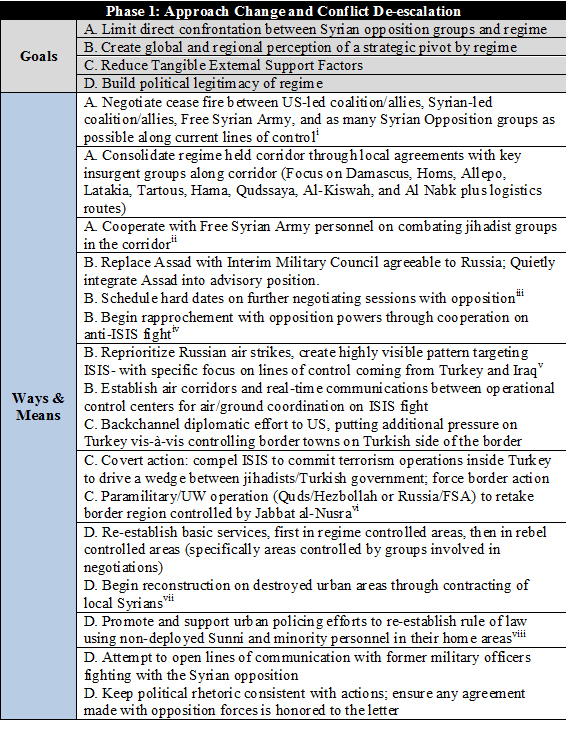
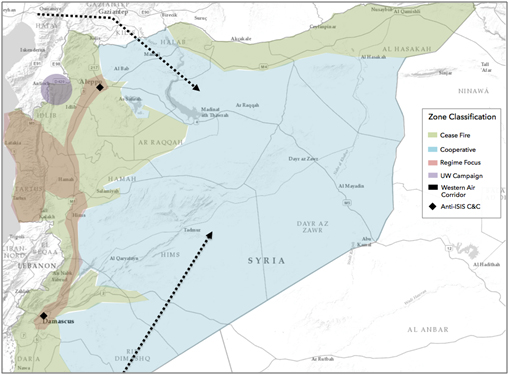
Phase 1 Campaign Map
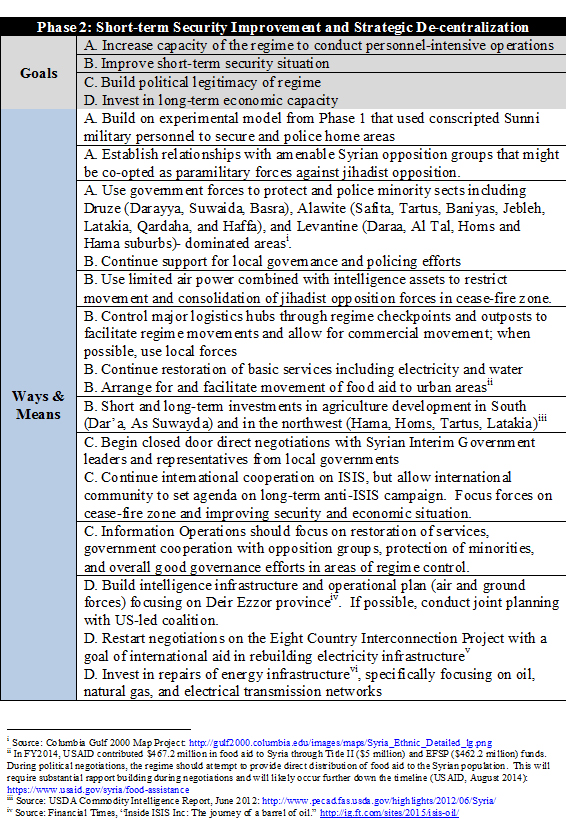
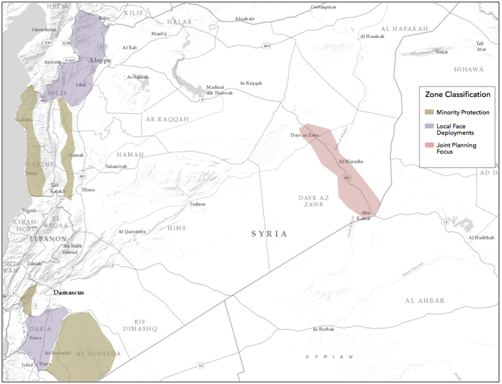
Phase 2 Campaign Map
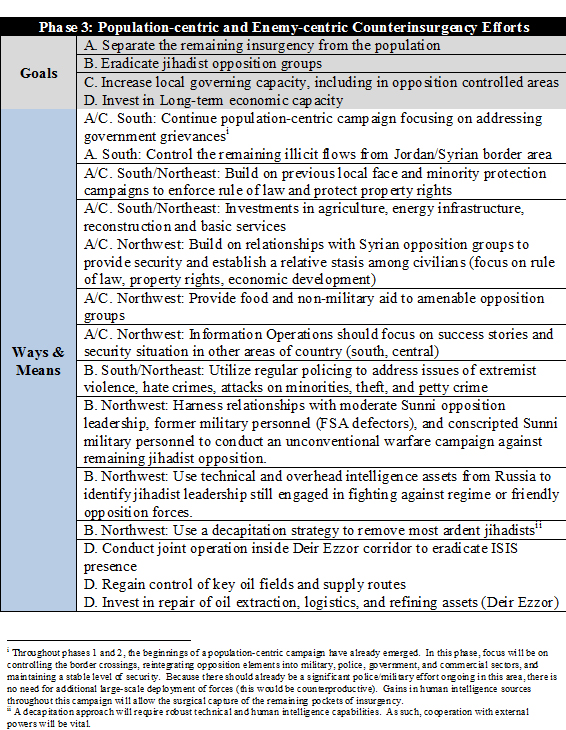
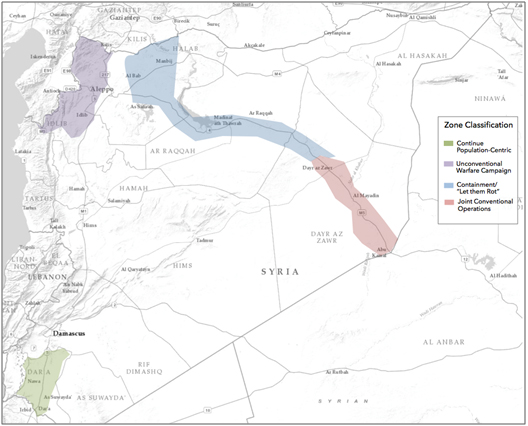
Phase 3 Campaign Map

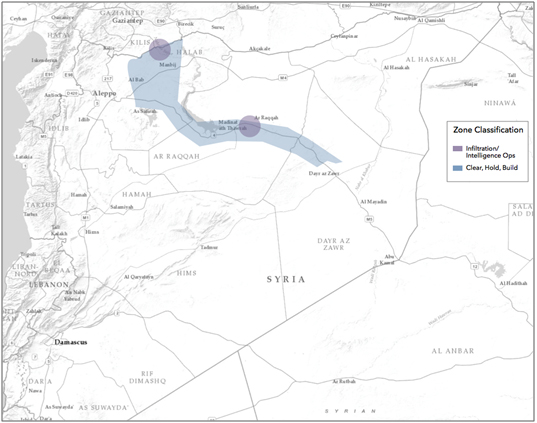
Phase 4 Campaign Map
Conclusions
To many observers of the Syrian conflict, the prospects for stability are bleak. Indeed, the Assad regime, time and again, has poisoned the prospects for short and long term peace through its heavy-handed approach to counterinsurgency. Still every day, battle lines are redrawn, allegiances shift, and an unforeseen event forces re-examination of popular opinion. This staggering line of progress in Syria need not be random. A new approach, one that harnesses the chaos, uses national diversity as an advantage, and systematically builds the legitimacy of central governance, can be successful. Despite hundreds of opposition groups, dozens of foreign interveners, and a jihadist group bent on returning the country to the seventh century, only the Syrian regime has the power, resources, and position to ensure the future of Syria. Deliberate progress starts with a new plan.
End Notes
[i] Starr, Stephen. Revolt in Syria: Eyewitness to the Uprising. New York: Columbia University Press, 2012. 7.
[ii] Patrick Seale discusses the centuries old conflict in Syria between Sunni, Shia, Alawite, Kurds, and other religious/ethnic groups and the effects of foreign competition in the region. Seale, Patrick, and Maureen McConville. Asad of Syria: The Struggle for the Middle East. Berkeley: University of California Press, 1989. 3-13.
[iii] The debate over the role of Islam in Syrian governance ultimately set the conditions for the rise of the Ba’athist Party- a party founded on the concept of Arab nationalism and pan-Arabism rather than sectarianism. The rise of the Ba’athist party afforded power to the Al-Assad family in the 1960s through present day. Seale 30-33.
[iv] Thomas Hegghammer discusses the role of Saudi Wahhabism on modern Islamist jihadi groups including Al-Qaeda in “Jihad in Saudi Arabia”. Jessica Stern and J.M. Berger take this discussion further in its relation to the ideology of ISIS in “ISIS: The State of Terror.” Hegghammer, Thomas. Jihad in Saudi Arabia: Violence and Pan-Islamism since 1979. Cambridge, UK: Cambridge University Press, 2010; Stern, Jessica, and J. M. Berger. ISIS: The State of Terror. New York, NY: HarperCollins, 2015.
[v] Recent attacks outside of Iraq/Syria by ISIS have refocused nations in their effort to contain the spread of violent jihadism from extending outside of the region. This New York Times timeline outlines recent attacks: http://www.nytimes.com/interactive/2015/06/17/world/middleeast/map-isis-attacks-around-the-world.html. The idea of ‘containment’ originates from U.S. Cold War strategy, but has been re-applied to the modern context of ISIS in the Levant. Clint Watts of the Foreign Policy Research Institute describes this new containment effort by the US-led coalition as the “Let them Rot” Strategy: http://www.fpri.org/geopoliticus/2014/09/us-cant-destroy-isis-only-isis-can-destroy-isis-unfortunate-merits-let-them-rot-strategy
[vi] Competition between Sunni (Saudi Arabia, Turkey, Qatar) and Shia (Iran, Syria, Hezbollah) blocs was a main escalatory factor in the conflict as well as a significant barrier to political settlement: http://www.nytimes.com/2015/10/30/world/middleeast/syria-saudi-arabia-iran-peace-talks.html
[vii] Ryan Evans traces Russian involvement in the Syrian conflict to a storied history of foreign interventions and the Russian approach to International Power Politics: http://warontherocks.com/2015/12/moscows-clients-from-kabul-to-damascus-strength-and-strategy-in-international-politics/
[viii] John Cassidy addresses the United States’ “vital interests” in Syria: http://www.newyorker.com/news/john-cassidy/americas-vital-interests-in-syria
[ix] The Institute for the Study of War analyzes the Iranian campaign and its efforts to project power abroad: http://www.understandingwar.org/sites/default/files/IranianStrategyinSyria-1MAY.pdf
[x] ‘Today’ will be defined as Friday, December 11, 2015. All real-world events that take place following this date will not be considered in the campaign plan presented here.
[xi] Barry Strauss provides a detailed account of the slave rebellion against the Roman government in the first century BCE. While this was an early example of an insurgency and a counterinsurgent response, it is certainly not the earliest. Strauss, Barry S. The Spartacus War. New York: Simon & Schuster Paperbacks, 2010.
[xii] The title references an Institute for the Study of War report entitles “The Assad Regime: From counterinsurgency to civil war.” http://www.understandingwar.org/sites/default/files/TheAssadRegime-web.pdf
[xiii] Reporting in October 2011, Liam Stack profiled the emerging Free Syrian Army in Turkey: http://www.nytimes.com/2011/10/28/world/europe/turkey-is-sheltering-antigovernment-syrian-militia.html
[xiv] Ghaith Abdul-Ahad discusses the role of Syria in the Iraq insurgency (Washington Post, 2005): http://www.washingtonpost.com/wp-dyn/content/article/2005/06/07/AR2005060702026.html
[xv] Qiad Fares discusses these and other aspects of the new Syrian Constitution in “The Syrian Constitution: Assad’s Magic Wand”: http://carnegieendowment.org/syriaincrisis/?fa=55541
[xvi] Ryan Evans discusses the Russian approach in “Moscow’s clients from Kabul to Damascus”: http://warontherocks.com/2015/12/moscows-clients-from-kabul-to-damascus-strength-and-strategy-in-international-politics/
[xvii] AEI’s Critical Threats Project discusses the nature of the Iranian approach in Syria, which includes using IRGC Ground Forces, Quds Force, Shia militias, and Lebanese Hezbollah forces to exert influence on the ground. In Iran’s view, Syria provides a critical foothold and strategic depth that enables its vital interests in the region. The report concludes that Iran’s approach is based partly on a desire to hedge against regime collapse while maintaining the ability to move freely despite a range of outcomes in Syria. http://www.irantracker.org/analysis/fulton-holliday-wyer-iranian-strategy-syria-may-2-2013
[xviii] The ISW report “The Assad Regime: From Counterinsurgency to Civil War” details the shift from ‘clear and hold’ to ‘cleanse’. http://www.understandingwar.org/sites/default/files/TheAssadRegime-web.pdf
[xix] The European University Institute, Migration Policy Center recently launched a website that details the refugee crisis, migrant smuggling routes, and a refugee timeline focusing on Syria: http://www.migrationpolicycentre.eu/migrant-crisis/ The flow of refugees from the Syrian civil war has rapidly become a centerpiece of US and European policy debate due to a perceived risk of extremist penetration through Refugee Programs. Daniel Byman, Brookings research director and Georgetown University professor, soberly assesses the refugee-terrorism threat (Lawfare, October 2015): https://www.lawfareblog.com/do-syrian-refugees-pose-terrorism-threat
[xx] Many of the counterinsurgency prescriptions presented here are taken from “Good COIN Practices”- which were empirically derived in the RAND Study: “Paths to Victory: Lessons from Modern Insurgencies.” Paul, Christopher, and Colin P. Clarke. Paths to Victory: Lessons from Modern Insurgencies. RAND National Defense Research Institute, 2013.
[xxi] In “Wrong Turn”, Colonel Gian Gentile discusses the construction of the counterinsurgency narrative in American culture. US information operations used a compelling combination of “force reinvention” narrative and replacement of leadership highlight a changing US approach in each theater. Gentile, Gian P. "The Construction of the Counterinsurgency Narrative." In Wrong Turn: America's Deadly Embrace of Counterinsurgency, 11-33. New York, NY: New Press Books, 2013.
[xxii] Genocidewatch.org lists a series of early warning signs that might point to deliberate targeting of minority groups by the Sunni majority in “Genocide and Mass Atrocities Alert: Syria; Updated 26 April 2013”: http://www.genocidewatch.org/syria.html
[xxiii] The Syrian government has major problems when it comes to supplying the country with electricity and a commercial oil supply. Currently, only the Banias refinery is functioning- which processes Supertanker shipments of crude from Iran. All three export terminals, at Latakia, Banias, and Tartous have ceased operation (because there is no oil production to export). ISIS controls almost all major oil fields (mostly in the Deir-ez-Zour province). Air strikes against ISIS targets have already caused significant damage to the oil infrastructure in that area. Retaking Deir-ez-Zour should be the primary focus in the ISIS fight as should restoration of the oil infrastructure post-ISIS. Syria will have to restart production and export of crude if it hopes to make tangible gains in economic development and reconstruction. Information on energy was derived from EIA’s Syria page: https://www.eia.gov/beta/international/analysis.cfm?iso=SYR
[xxiv] According to the US Department of the Treasury, sanctions against the Syrian regime are among the most comprehensive currently implemented by the Office of Foreign Assets Control. No doubt, the lifting of some economic sanctions will be the main bartering chip of the US-led coalition in upcoming talks. And rightfully so- the Syrian regime will be reliant on external support until trade and capital flows re-open: https://www.treasury.gov/resource-center/sanctions/Programs/Documents/syria.pdf
[xxv] Michael Eisenstady and Jeffrey White assess Iraq’s Sunni Arab insurgency and detail the effects of rampant unemployment among military aged Sunni males (Military Review, May-June 2006): http://www.au.af.mil/au/awc/awcgate/milreview/eisenstadt-white.pdf
